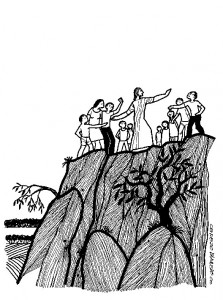Luke 4:1-13
This text is used for the Lectionary Year C on February 14, 2016.

Jesus’ journey into the wilderness serves as an annual launching pad for our own 40 day journey into the Lenten wilderness. Occurring with variation in each synoptic, the preacher may be tempted to choose another lection this year. Before doing so, the preacher should consider whether they have sufficiently mined Luke’s depiction of Jesus’ testing, for it is rich with biblical allusion and spiritual guidance.
The first few verses alone are packed with dots that need to be connected. The 40 day journey immediately reminds us of other biblical heroes who have undergone a similar experience. Moses’ 40 day fast (Exodus 24:28; Deuteronomy 9:9) and Elijah’s 40 day flight to the mount of God (1 Kings 19:4-8) come to mind, offering a subtle connection here between Jesus, the great law giver and the great prophet. Then there’s the not-so-subtle connection between Jesus and Israel. Jesus passed through the waters of the Jordan (Luke 3:21-22) just moments before being led into the wilderness by the Spirit. His first temptation: To make bread (think: manna). The connections between Jesus’ 40 days and Israel’s 40 years are not coincidental. Look closely. Jesus answers each test with a quote from Deuteronomy, the book that begins “these are the words Moses spoke to all Israel in the wilderness east of the Jordan…” (Deuteronomy 1:1). Two of those quotes (Deuteronomy 6:13; Deuteronomy 6:16) come right after the prayer faithful Jews were to pray twice daily, the Shema, and the third comes within 2 chapters (Deuteronomy 8:3). In this story Luke identifies Jesus as both Israel and the model Jew, and the biblical allusions don’t stop there. Instead, Luke continues to draw a line from Jesus’ present experience all the way back to the beginning.



